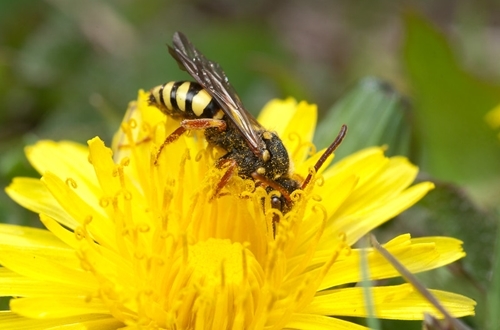
When somebody says the word ‘bee’, your mind probably springs to an image of a big fuzzy bumblebee, clumsily flying between flowers or bumping into your kitchen window. Or maybe you think of a hive of honeybees, dancing across an array of wax and honey. Both bumblebees and honeybees are eusocial meaning that they live in highly co-operative colonies with many worker bees serving a queen by caring for her young. But did you know that 90% of the UK’s 270 bee species are actually solitary bees?
Unlike social bee species, solitary bees build individual nests and work alone. Once an adult female has emerged from her pupae and has mated with a male (who dies soon after), she builds an individual cell for each egg she lays, along with a small ball of pollen and nectar which the larvae eat once they hatch. The adult female’s job is now complete and like the male, she dies, leaving her offspring to fend for themselves. winter until they pupate into adult bees in the spring. At this point they emerge to start the cycle all over again, living in their adult stage for as little as four to six weeks.
Due to there being such a wide variety of solitary bee species, they can be relatively hard to identify, with
some species easily being mistaken for wasps, hoverflies, nor honeybees. Some of the more common species you might be likely to stumble across include the red mason bee, patchwork leafcutter bee (both of which may inhabit a bee hotel in your garden), and the ashy mining bee which gets its name from its distinctive ash-grey bands on its thorax. These bee species can be found in the new BEESPOKE identification guide for solitary bees of the UK, which includes high quality photos of 34 more commonly seen species, along with descriptions of many others.
So next time somebody says the word ‘bee’, maybe your mind will instead spring to an image of a solitary
bee, carefully building her nest and collecting pollen for her young, playing an incredibly important role in pollination in the process. Better yet, get outdoors and bring that image to reality, using the BEESPOKE solitary bee guide to help with identification to find out more about the pollinator population that surrounds you.
MORE INFORMATION
The BEESPOKE project (Benefiting Ecosystems through Evaluation of food Supplies for Pollination to Open up Knowledge for End users) aims to increase levels of pollinators and crop pollination at local and landscape scales by providing land managers and policymakers with new expertise, tools and financial knowledge to create more sustainable and resilient agroecosystems. For further information and free guides visit https://northsearegion.eu/beespoke/